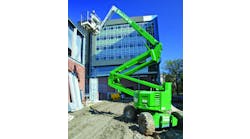People in the rental industry — both rental companies and suppliers to it — have been talking a lot lately about costs. Obviously the cost of fuel affects everybody. The costs of steel, copper, tires and so many components are making it difficult for manufacturers to keep their costs down. And rental companies are faced with skyrocketing delivery costs. And those costs become more worrisome when revenues are flat or worse. As one rental company owner said to me last week, “It's hard enough that each delivery costs me twice what it did a year ago; I wouldn't mind it so much if I had as many deliveries to make.” The combination of increased costs and slower business is taking a serious toll on this rental business and many others.
It looks to me that there are some cracks in the foundation of the manufacturer-rental company partnership that has been carefully constructed in recent years and it's not hard to understand why. The manufacturer, faced with spiraling cost increases, needs to increase prices to remain profitable. The rental company, faced also with burgeoning costs and soft business, wants to replenish fleet and wants the manufacturer to not only not increase prices but, in some cases, even reduce them.
It reminds me of that old Ray Charles song, “Busted.” A man is broke, so he calls his brother for a loan. But his brother responds by reciting his litany of financial pressures and says, “I was just thinking of calling on you.” It's a vicious circle and one that won't easily find a satisfying outcome as long as business is soft.
That's why partnering is important. The problems rental companies and manufacturers face are different, but related. Both ends of the supply chain, if they aren't doing so already, need to take long looks at their costs and figure out ways to cut waste, operate more efficiently and streamline. Many rental companies are looking at solutions such as dispatching software; telematics to help track, diagnose and service equipment; and various forms of electronic data interchange to reduce transaction costs.
There are many tools that can help, but ultimately more important than the tools, more important than the software, is the partnership attitude. There needs to be far more constructive dialog on how different links in the supply chain can work together to lower costs for all sides. Partnerships between manufacturers and rental companies are not about sitting around the campfire and singing “Kumbaya.” It's about really working together to make processes more cost-effective, linking back-office systems together for more harmonious interaction.
It's not just asking for a price break. It's more about cutting costs and re-engineering business processes so the price breaks aren't necessary.
Dave Christifulli, former Wacker executive and now president of his own consulting group — which includes former manufacturing personnel as well as former rental company executives — told me of a rental company executive he recently spoke with who admitted that the average cost per part order for his company was more than $150, closer to $165. So ordering a $25 part might cost $190. Multiply that times the thousands of parts the rental company orders each month and the implications are mind-boggling.
That rental company can beg for a deeper parts discount, but until its systems are revamped, it's still on a fast track to serious trouble. If that company can reduce its transaction costs even by half, it can save millions.
It can be done. I've seen some dramatic turnarounds in the fortunes of equipment rental companies through systems re-engineering. Such transformations can make economic challenges far less threatening.
As one economist recently said, downturns occur for a reason, or for a number of reasons, to correct inefficiencies in the supply chain. The solutions arrived at to overcome a downturn tend to correct those inefficiencies. As far as the rental industry is concerned, we certainly saw that to a degree in the early part of this decade when massive over-fleeting created a serious imbalance between supply and demand that began to be corrected by the rental companies themselves, setting the stage for the next economic upturn.
The current construction downturn was caused by other factors, such as the credit situation, which I needn't rehash here, although obviously the construction industry and the rental industry benefited by all those homes being built, and the commercial construction required to support those housing developments. But to survive this period, rental companies and manufacturers need to correct inefficiencies in the system. And the sooner steps are taken to correct inefficiencies that cost a rental company $190 for a $25 part, the quicker the rental industry will be equipped to rise out of the quagmire of the current economy.





